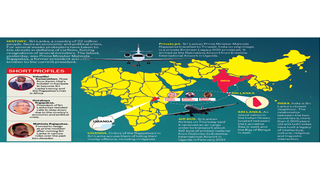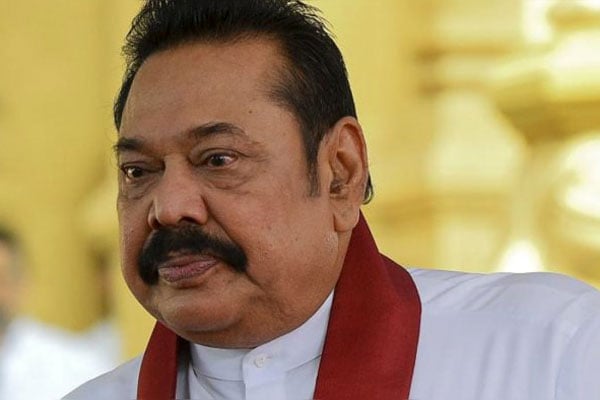
*Above is a graphic tracing links between the two countries
|Special Reports
Prime
Uganda flights help sink Sri Lanka leader
What you need to know:
- A 102-tonne cargo delivery by national carrier and a $100,000 private jet flight from Entebbe put Uganda in the heart of a political crisis half the world away.
Few Ugandans would name the capital city of Sri Lanka, let alone find the Asian country on a map. Yet Uganda has surprisingly featured prominently in the protests that have rocked Colombo – that is the name of Sri Lanka’s capital city – for weeks, and culminated in the resignation of Prime Minister Mahinda Rajapaksa yesterday.
It all started with a tweet. On February 23, 2021, Sri Lanka’s Airline Pilot’s Guild tweeted that it had flown three planeloads of cargo to Entebbe International Airport in Uganda.
Eagle-eyed Sri Lankan journalists were piqued. Of Sri Lankan Airline’s 117 destinations at the time, none was in mainland Africa. The coronavirus pandemic was also raging and air travel had collapsed across the world.
What was Sri Lanka Airlines flying to Uganda, of all places?
There were more questions flying around in Sri Lanka. Bad luck and bad decisions had created an economic crisis on this island of 22 million people.
Borrowing spree
The country had gone on a massive borrowing spree to pay for infrastructure projects through which a lot of money was lost to corruption, critics said. Heavy monsoons and a ban on chemical fertilisers then destroyed farmers’ crops.
Terrorist bombings at luxury hotels and churches during Easter 2019 killed hundreds of people and the country’s tourism sector. And then came Covid-19. Anything that could go wrong had gone wrong.
The government cut taxes to boost growth but its public revenues plunged as a result. The government then turned to its foreign exchange reserves to pay off the growing mountain of debt but rather than climb out of the hole, it was digging itself deeper into trouble. Between 2018 and last month, the reserves evaporated from $6.9 billion to $2.2 billion, according to official data.
Unable to pay for vital imports like fuel, and with the Sri Lankan rupee losing value rapidly, prices began soaring.
Apart from the bad luck and the bad decisions, journalists in Sri Lanka were also following allegations of grand corruption in the government led by President Gotabaya Rajapaksa and his elder brother, Prime Minister Mahinda Rajapaksa.
After helping to defeat the Tamil rebellion, the Rajapaksa family had become hegemonic in Sri Lanka; Mahinda had been prime minister in 2004-05, president and defence minister between 2005 and 2015, prime minister again briefly in 2018, and leader of Opposition in 2018-2019 when the family briefly lost power. When the younger Rajapaksa became president in 2019, Mahinda bounced back as prime minister.
As the economic crisis raged, the opposition in Sri Lanka and critics of the government accused the Rajapaksa family of siphoning public funds out of the country and hiding them overseas.
Then the flight to an unusual country, in the middle of a pandemic, carrying unspecified cargo, happened. To add to the suspicion, when journalists checked again, the tweet had been deleted.
And when they filed a freedom-of-information access request for details of the flight, the authorities in Colombo cited commercial confidential reasons in refusing to provide details beyond revealing that the cargo on the three Airbus A330 chartered flights was “printed materials”.
It is possible that the matter could have died here. But on December 23, 2021, Prime Minister Mahinda went on a pilgrimage to Tirupati, a holy city in the Indian state of Andhra Pradesh, using an Embraer Legacy 600 private jet. A few days later, officials from the opposition Frontline Socialists Party revealed that the trip had cost almost $100,000 and wondered why the PM of a country facing an economic crisis had not flown commercially.
The officials also revealed that in the days before the flight to Tirupati, the private jet registration T7-JSG had flown from India to Nairobi, flown to several locations in Kenya, then to Bukoba in Tanzania, before flying to Entebbe, and then on to Colombo International Airport, Ratmalana. Uganda was back into the picture.
Growing footprint
Unlike its next-door neighbour India whose nationals have been a constant presence since they arrived to build the Uganda Railway in the late 1890s, Sri Lanka for many years had little or no visible presence in the country.
In the late 1980s a young Sri Lankan named Velupillai Kananathan turned up in Kampala and was soon under the wings of businessman Karim Hirji whose hotels he helped manage. What Kananathan lacked in qualifications and pedigree, he more than made up for in ambition and street smarts.
A photo had been taken of him with Uganda’s President Museveni sometime in the early-to-mid nineties and he went to great lengths to ensure that it was used with every story in which he was subsequently mentioned in the local press.
In 2001, Kananathan was the brains behind Tri Star Apparel, a company set up in Kampala to manufacture garments for export to the United States under the American Growth and Opportunities Act, Agoa.

President Museveni introduces Hajj Habib Kagimu, a Kampala businessman (right), to the Sri Lankan leader , Mahinda Rajapaksa (centre). PHOTO/PPU
However, promised investments from Sri Lanka, which has a more advanced textiles industry, never came.
The few textiles exported were merely imported from Sri Lanka and had ‘Made in Uganda’ labels sewn on, and the workers went on strike to protest low wages and slave-like conditions.
When the company finally shut down in 2006, it was revealed that government had propped it up from inception, losing Shs24 billion in the process in loans and subsidies.
But a link had been created between the two countries. President Mahinda Rajapaksa visited in 2007 and attended the Commonwealth Heads of Government Meeting in Kampala that year, before returning in 2013 to preside over the opening of Sri Lanka’s first High Commission. In that time Kananathan, who helped organise both trips, had risen up the rungs to become Sri Lanka’s Honorary Consul in Kampala.
By May 2021 when he presented his credentials to President Museveni, Kananathan had become Sri Lanka’s High Commissioner to Kenya and to eight other countries in the region, including Uganda, resident in Nairobi.
A year earlier, he had also been appointed Special Envoy to Africa by, Mahinda, who was now back in office as prime minister.
Critics of the Rajapaksa’s in Sri Lanka accuse them of hiding their money offshore, including in Uganda and list many companies that they allege are associated to the family. These allegations have not been independently verified. And many online and social media records belonging to some of these companies have been erased since the allegations were made public.
Encouraged by Ugandan authorities, there has been a sharp increase in Sri Lankan companies opening up in the country since Rajapaksa’s first visit and in the decade-and-half that has followed. They are involved in building small hydropower stations, construction, entertainment and hospitality, among others.
Some of the allegations linking transactions between the two countries to criminal activity are baseless or hard to prove. For instance, following public pressure, Sri Lankan Airlines eventually revealed that the 102 metric tonnes of printed material it airlifted to Entebbe in February 2021 were Ugandan currency notes shipped by De La Rue from its printery in Colombo.
In a statement, the printing firm added: “De La Rue provides banknotes for half of the central banks around the world. We do this from our sites in Sri Lanka, Kenya, Malta and the UK, with joint ventures in Sri Lanka and Kenya that contribute to the economies of those countries. We do not comment on our customers.”
Bank of Uganda in mix
Two Central Bank officials in Uganda independently confirmed the printing contract with De La Rue and receiving bank notes around the same time but refused to speak on the record and said they were not in position to say if the flights carried anything else.
Yet the claims of Uganda as a money laundering destination – even unproven ones – could have lasting negative consequences on the country.
Warning
In January, Sydney Asubo, the head of the Finance Intelligence Authority, warned that Uganda risks being blacklisted by the Financial Action Taskforce (FATF), a global money laundering and terrorism financing watchdog, by May 2022.
“Uganda was placed in the grey list in 2020. It means the country has been identified but it made commitments with the FATF to address the specific issues within a given time frame,” he told the Finance committee of Parliament.
“Unfortunately, a number of issues are still outstanding so the FATF is concerned and has written that if these issues are not addressed, then the country will be moved to the blacklist.”
Mr Asubo’s comments were picked up by Sri Lankan mainstream and social media, reaffirming corruption accusations in the country against their ruling family. Whether true or merely self-reinforcing, the money laundering claims have toppled one Rajapaksa and could claim another as Sri Lanka’s political crisis deepens.
Like their East African counterparts, not many ordinary Sri Lankans would have heard of or been able to locate Uganda but the current crisis has put Uganda on the map and a key discussion point in a political drama thousands of miles away.
Perfect storm
- Government debt has spiralled out of control, and critics say flagship infrastructure projects were avenues for large-scale corruption.
- Unusually heavy monsoon rains destroyed farmers’ crops and a ban on chemical fertilisers harmed recovery in harvests.
- A terrorist attack on churches and luxury hotels at Easter in 2019 harmed the tourism industry. Then Covid-19 finished it off.
- Government slashed taxes in a bid to restart economic growth but it then ran out of money to settle its bills, including debt repayments.
- Sri Lanka then turned to its foreign exchange reserves to pay its bills, but these have dwindled and left it unable to support its currency.
- The Sri Lankan rupee was then allowed to float freely but it has lost value, making key imports expensive, including fuel.
Uganda and Sri Lanka
2001: Tri-Star Apparels, a Sri Lankan firm sets up shop to export garments to USA. Goes under in five years with Shs24 billion in public funds.
2007: President Mahinda Rajapaksa visits Uganda and attends the Commonwealth Heads of Government Meeting (Chogm) in Kampala.
2013: President Mahinda Rajapaksa returns to Uganda to officiate at the opening of the Sri Lankan High Commission in Kampala.
2021: Velupillai Kananathan, a former honorary consul, received in Kampala as Sri Lanka’s High Commissioner to Uganda, Kenya, and seven other countries.




